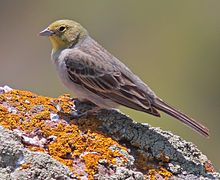| This article includes a list of references, related reading, or external links, but its sources remain unclear because it lacks inline citations. Please help improve this article by introducing more precise citations. (September 2024) (Learn how and when to remove this message) |
| Cinereous bunting | |
|---|---|

| |
| Adult male | |
| Conservation status | |
 Near Threatened (IUCN 3.1) | |
| Scientific classification | |
| Domain: | Eukaryota |
| Kingdom: | Animalia |
| Phylum: | Chordata |
| Class: | Aves |
| Order: | Passeriformes |
| Family: | Emberizidae |
| Genus: | Emberiza |
| Species: | E. cineracea |
| Binomial name | |
| Emberiza cineracea Brehm, 1855 | |
The cinereous bunting (Emberiza cineracea) is a bird in the bunting family Emberizidae, a passerine family now separated by most modern authors from the finches, Fringillidae. This species was first described by Christian Ludwig Brehm.
Range
It breeds in southern Turkey and southern Iran, and winters around the Red Sea in north-eastern Africa and Yemen. A few isolated populations maintain a foothold within European borders, on Greek islands in the Aegean Sea, especially Lesbos.
Habitat
The cinereous bunting breeds on dry stony mountain slopes.
Description
The cinereous bunting is a large (16–17 cm), slim bunting with a long, white-cornered tail. The term cinereous describes its colouration. It is less streaked than many buntings and has a thick pale bill. It has a greyish back with only subdued dark markings, and a browner tint to the wings.
The adult male's head is dull yellow, with a brighter moustachial line and throat. In the nominate race of south-west Turkey, the rest of the underparts are grey, but the eastern form E. c. semenowi has yellow underparts.
Females are brownish grey above with a whitish throat and yellow only in the moustachial stripe. Young birds have a plain pale belly and streaking on the breast.
Foraging and breeding
Like other buntings, the cinereous bunting feeds principally on seeds. It takes insects especially when feeding its young. Its normal clutch is three eggs.
Song
The call is a harsh tschrip, and the song is a hoarse zru- zru-zru-zru.
References
- BirdLife International (2021). "Emberiza cineracea". IUCN Red List of Threatened Species. 2021: e.T22720912A205540097. doi:10.2305/IUCN.UK.2021-3.RLTS.T22720912A205540097.en. Retrieved 13 September 2024.
- "Lesvos: A birdwatcher's paradise full of rare species | eKathimerini.com". www.ekathimerini.com. 2024-11-05. Retrieved 2024-11-05.
- Buntings and Sparrows by Byers, Olsson and Curson, ISBN 1-873403-19-4
This article about a bird of the family Emberizidae is a stub. You can help Misplaced Pages by expanding it. |